
Bengal tiger at the Sri Jayachamarajendra Zoo in Mysore
Summary: Here's notes from my trip to India: the food, the people, the language, the traffic, animals and landscape, palaces and temples, clothes and fashion, and what's up with all the high tech in India. It's an FAQ about traveling to Bangalore.
Read this page in your language
Why We Were in Bangalore

In January 2006, Stephanie Cota and I cofounded a company which was funded by investors in both Silicon Valley and India. A company in Bangalore also became part of this.
In May 2006, we went to Bangalore for two weeks of meetings and training. I didn't really know what to expect in India, so I kept notes and took several hundred photos. Here's the result. There is no particular order, asides from a few general categories.
Keep in mind, this isn't a description of India; it's only my experiences in Bangalore. It would be like someone coming to the USA and visiting just Palo Alto. Of Bangalore, I only dealt with others who work in the computer industry. So, remembering that, here are my notes about Bangalore, the Silicon Valley of India.
Bangalore / Bengaluru
Bangalore is in the south center of India. Along the east and western side of India, there are two mountain ranges, called the Eastern and Western Ghats. Between the two, there is a high plateau (about 1000m). You may have noticed: Indians are changing the names of cities, for no particularly good reason. Bombay is now Mumbai. Madras is now Chennai. Calcutta is Kolkata. And Bangalore will soon be Bengalooru. Whatever.
Bangalore used to be known as the Garden City of India, due to the many city parks, including the large 300-acre Cubbon Park in the center of city, similar to NYC's Central Park or San Francisco's Golden Gate Park. But that was 20 years ago, before Bangalore doubled, tripled, and quadrupled in population to seven million. I walked around Cubbon Park. The park is filled with families. At many corners, there are street vendors with juice, fruits, grilled corn, and so on. The effects of too many people are visible; the grass is thin, the sidewalks and paths are broken.
MG Road (Mahatma Gandhi Road, but everyone calls it MG Road) is the center of town. If there are lots of shops everywhere, there is an intense crush of shops on MG Road, along with many people.

Garlands of marigold and other flowers at the market.
From Cubbon Park, I walked to the market. This is a large multi-level hall with hundreds of vendors. Each aisle is specialized: the aisle for jasmine garlands, marigolds, incense, vegetables, fruits, onions, and so on. You can go down into the market, where it's dark and cool. I talked with people, sampled different things, and took a number of photos. People were very friendly.
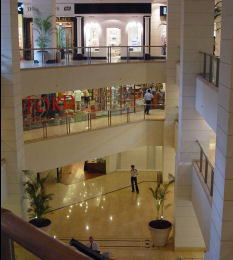
Most Americans don't realize there are malls in India. Not just a few. There are more than a dozen malls in Bangalore. The Leela Palace was a few blocks away, so we walked to it. It's a spectacular three story mall, which is part of the Leela Palace Hotel. There's a great café, a beautiful courtyard garden, a bookstore with a tea cafe, and shops with all the expensive global brands. There were quite a few people there, although the photo shows nobody. In the typical hodgepodge of city planning, the same block also has people living in hand-built huts. I expect Robert Venturi, the Pritzker Architecture Prize winner, would be quite happy with Bangalore's city planning; the architecture is vernacular and you see everything jammed together in a chaos of styles, traditions, and materials.
There's not much to see in Bangalore. Most of it looks the same: long streets filled with small shops, street vendors, heavy traffic, and lots of people. Paris, London, Berlin, and Rome were designed to have large public spaces and monuments, which makes those cities photographable. You stand at a point in Paris and can see down long boulevards to grand monuments. But there's not much to photograph in Bangalore. There's very little public art; maybe an occasional sculpture, but not like in Europe or North America. Major public areas are devoid of decoration. The central bus area is a vast dusty surface, with buses and people milling around. In places, you walk through or over huge piles of rubble.
One night, we went to the movies. In the USA, you sit wherever you like, but in India, similar to Denmark and other European countries, you buy the seat, just like in a theater. The best seats cost more. Indians complain about prices, but it's $2 for the best seats. At the concession stands, you can load up on all the bad stuff: candy, popcorn, cotton candy, Coke, and so on. The main difference is the sound; they crank up the volume. It's digital, so it's extremely loud. We watched an action movie, and when the explosions came, I nearly leaped out of my seat. Seats are very comfortable because Bollywood movies are three hours long. There's always an intermission so you can load up on more popcorn and candy.
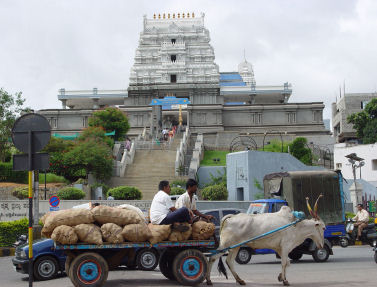
One morning, I went to the Iskcon Temple, the largest and wealthiest Hindu temple in Bangalore. It's quite worthwhile to visit. Occupying the top of a hill, the temple rivals the cathedrals of Europe in size and opulence. You leave your shoes and camera at the check-in counter and walk barefoot up endless stairs into the temple. At various levels, visitors prostate themselves before the temple's gods. Attendants wash the floors continuously to keep them clean. The gods are decorated with gold, silver, jewels, and jasmine garlands.
After visiting the main temple, you pass downwards through a series of floors, where there are shops with figurines of gods, posters, T-shirts, incense, books, postcards, and so on. The temple is a holy site: all major credit cards accepted. There are also four or five food stands, along with a grocery store. One food stand had 42 types of sweets, pastries, and rice dishes, all served on fresh banana leaves, for 10 cents or so. Nearly all of those were cooked rice or baked pastries, so you can eat them. I tried a variety of foods. Whatever looked interesting or delicious. Along the walls, there are carpets where you sit to eat. Quite a few families were picnicking. There is endless chanting by monks, which you can hear at their website IskconBangalore.org.
The website has a great collection of recipes by Lakshmi Priya Devi Dasi for drinks, vegetarian dishes, and so on.
It's a common rule: no shoes or cameras in museums, temples, or palaces. This is a pity; the photos in the postcards tend to be 10-20 years old. If you're not used to walking barefoot, it'll hurt.
Visiting Mysore
One day, I hired a driver and went to Mysore, 130 kilometers southwest of Bangalore (about 80 miles). That doesn't sound very far, but with the slow, heavy traffic, it takes 3-5 hrs. It's inexpensive to hire a driver, about $75 for a whole day.

The landscape is mostly flat, with slight rolling terrain, and occasional granite outcroppings. There are plantations of palm trees, sugar cane fields, and rice fields along the way.
I started at the government-owned Sandalwood Oil Factory. It's a sleepy factory, with hardly any activity, yet it produces about half of the sandalwood oil in India. Opened in 1917 and unchanged since, they prepare sandalwood oil by hand. After trees have matured to 30 years, the logs are brought to the factory, where it is first split into smaller logs and then fed into a chipper. The noise is spectacular. None of the workers wear hearing protection. The chips are milled down into a powder, which is then baked in a row of vertical stills, which gives off a rich aroma, somewhat like sandalwood on toast. Water is injected into the stills and heated; the vapor is distilled to produce the oil. All of this is done by hand, using little more than what you can find in your kitchen. The machines were at least 30-50 years old. If you ask, the manager opens a tiny shop, where you can buy a 5 gram bottle of pure sandalwood oil for 650 rupees (about $15). For whatever reason, you can't take photos in the factory.
I went to the Palace in Mysore. Like Versailles near Paris, this palace celebrates unlimited wealth. The halls are spectacular. If you're familiar with European interior architecture, the Indian palaces are a fascinating contrast in colors, shapes, and materials, including gold, mahogany, teak, and so on. For example, the door to the smaller royal hall is made of 300 kilos of silver. The side doors are teak with hunting scenes inlaid with silver and ivory. The pillars are gilded with pure gold. As with temples, you leave your shoes at the front gate and walk barefoot. This isn't a bad idea; it protects the floors. The floor at Versailles and many European cathedrals and palaces has been ruined by shoes. Visit MysorePalace.org See photos of palace halls, incl. 360° views of halls.
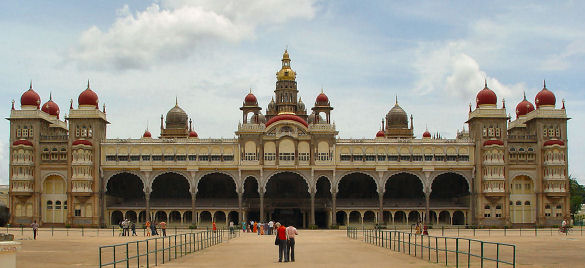
The Palace at Mysore. The front is open-air and faces out onto a large plaza.
However… I don't know how much of this architecture is actually Indian. The Mysore palace was designed by the architect Henry Irwin, an Englishman, in the early 1900s. Although it looks Indian, it was actually built in Europe. The pillars were made by craftsmen in Scotland, the glass is from Belgian glassworks, and so on.
Above the city, there is the Sri Chamundeswari Temple. It sits atop a 1062m bluff, with a good view of Mysore and the countryside. The temple is a very popular destination for Indians.
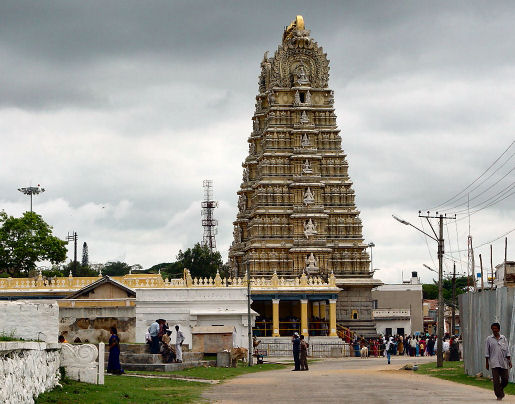
At Sri Chamundeswari Temple, there were long lines with a two-hour wait to go inside the temple. Several dozen cows roamed the temple grounds.
I walked around Mysore's Sri Jayachamarajendra Zoo, which has Bengal tigers, elephants, crocodiles, and so on. It's popular with Indians and somewhat crowded, but very shady. The tigers and elephants have large open spaces to wander around.
In the evening, I went to Brindavan Gardens, which is next to the Krishna Raja Sagara Dam. This is a set of water fountains in a 150-acre garden. At night, there is a water show, with colored lights and jets of water in motion to Bollywood music. This is very popular and festive; every evening, some 10-20,000 people show up. You're probably seen this if you watch Bollywood movies; many scenes have been set in the gardens. There's lots of food and drinks. You probably have the picture by now; wherever you go, there's lots of food and drinks.
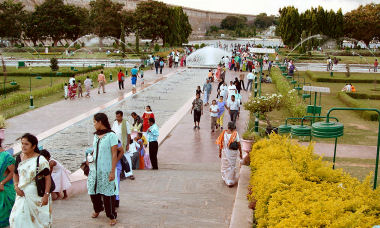
The Brindavan Gardens water show attracts a large audience every night.
Countryside
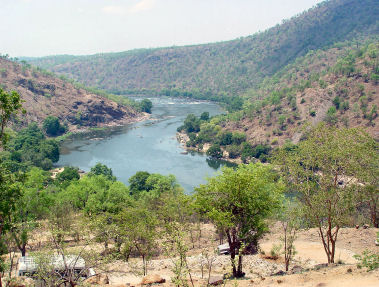
On Sunday morning, a pair of vans took everyone in the company to a national park about 100 km from Bangalore, where we spent several days at a campground on the Cauvery River, a few miles below the Krishna Raja Sagara Dam.
The landscape is beautiful, like the Sierras of California, with steep ravines that lead down to a beautiful river with cool water. We couldn't swim in the river because there are crocodiles, which are about 8-10 feet long. Stephanie saw a crocodile, and a week later, at another point on the river, I saw two crocodiles.
The campground was a contrast to Bangalore, nobody within sight, silent, and peaceful. No electricity or running water. There were monkeys in the trees.
Did we rough it at the campground? Hardly. A team of cooks prepared Indian food for breakfast, lunch, and dinner. They also included tea and toast at 7 am, tea at 4pm, and snacks at night.
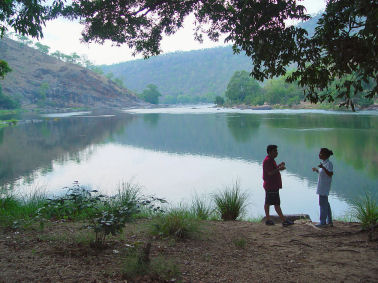
The evenings in India are cool and pleasant. In the city, people are outdoors until 11 pm.
Animals and Flowers
Everyone knows there are cows in the streets in India. Yes, I saw quite a few cows wandering around. They graze, they stand there, they lie on the ground and chew their cud. It's rather remarkable to see cows quietly standing next to busy roads, ignoring the traffic. It just doesn't seem possible that tens of thousands of cattle can walk about freely and peacefully in a large city, but, well, they do in Bangalore. Nobody takes care of them, nobody does anything about them. The cows appeared perfectly healthy and happy to me.
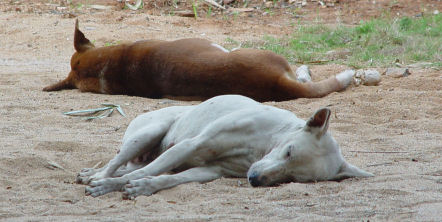
But I didn't expect the dogs. There are thousands of dogs in the streets. Nobody owns them, they just live on the streets. In every block, there were maybe two or three dogs, sometimes five. I'd guess there are several hundred thousand street dogs in Bangalore.
They live totally free, doing whatever they please, walking around in traffic, sleeping on the sidewalk, whatever, in Dog Heaven.
They're the same breed: mid-sized, short hair, and slim. The dogs are very docile. I went up to a few. They let themselves be petted. Sometimes, they watch you without curiosity. The dogs didn't howl at night. They mostly just slept. Laziest things I ever saw.
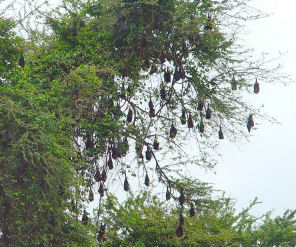
At dusk, you see plenty of fruit bats. American bats are small, the size of mice. The Indian fruit bats are the size of cats, with a three to five foot wingspan. They fly around at dusk and eat fruit, such as mango and banana.
During the day, several hundred fruit bats hang from trees and giant bamboo. Since they eat fruit, not insect, they don't have bat sonar, and, since they're bats, they don't see very well. When they arrive at their tree, they basically crash land.
You also see wild monkeys crashing around in the trees. There's lots of chipmunks, which the Indians call squirrels. There are also mango trees, which are very large. On the highway to Mysore, we passed lakes filled with water lilies.
As for birds, there's a wide variety. At the Ranganathittu Bird Sanctuary, I saw Open-billed Storks, Spoonbill, great Comorants, bright blue Kingfishers, lots of Myna birds, Egrets (the same as California egrets), Ibis (familiar from Egyptian tombs), and crows. Dozens of species and tens of thousands of birds stop here in their migration from Africa to Siberia and Northern Europe. The bird calls are very nice. You can hire a boat and guide for a few dollars. In the city, there are many eagles and kites (a type of raptor bird) soaring around.
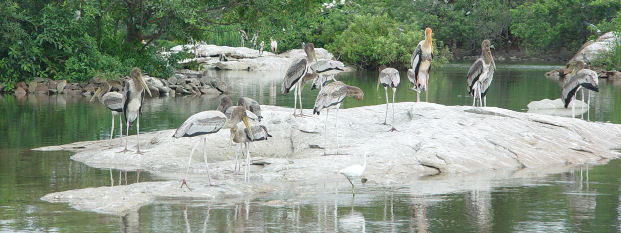
A flock of storks on the Cauvery River.
There are quite a few crocodiles in the river. With the boat, you can get rather close to them. They're shy and move away.

Like the dogs, the crocodiles are sleepy. This fellow is about ten feet long. Amazing, how much respect you can develop for a crocodile.
Indian English
Okay, I'll admit this topic is something that I've never really been clear about. We know English is spoken in India, but we don't realize that English is one of the languages of India. There are several dozen major languages and some 1,600 dialects, so English is their common language. The educated and the elite speak English as their first language, both at home and among themselves.
Practically everyone else also speaks English. In small restaurants, I talked with laborers. I also talked with people in small towns. One afternoon in Bangalore, I met a farmer who was unemployed and looking for work. We started chatting and ended up walking around for three hours. He spoke quite good English.
Indians speak quickly, and at first, I had to pay close attention, but after a week or so, I got used to Indian English. It's a version of English, just like Australian or British English. Some 150 million Indians speak English, so it's the world's second largest group of English speakers, not that much far behind the USA.
The Bhagavad-Gita is in Sanskrit, but that's a classical language like Latin or Greek to us, so most Indians read it in English. There are national newspapers, such as The Hindu, The Deccan Herald, and The Times, all in English. If you still think English isn't a native language of India, read The Hindu.
In the bus and in cars, we often listened to the radio. Pop stations were in English, with a mix of Madonna, Bollywood songs, Gwen Stefani, and so on. One night in the hotel, I scrolled through the 100 or so channels. A mix of Bollywood movies, TV game shows, soap operas, sports, and so on. On both radio and TV, the speakers often mix Hindi and English, which is jokingly called Hinglish.
Even the rickshaw wallah speak a bit of English, enough for directions. I found it a bit odd that generally, Indians don't speak other world languages, such as German, French, Chinese, Japanese, and so on.
Traffic and Infrastructure
If you think traffic is bad in LA or Silicon Valley, you've seen nothing. The traffic jams in Bangalore are a spectacular anarchy of cars, motorcycles, bicycles, and three-wheel taxis all jostling for position, squeezing into any available space, often only an inch or two apart, everyone honking at the same time, and the air thick with exhaust fumes. You can barely see ahead two blocks due to the fumes. There may well be traffic laws, but it seems as if there aren't. Nobody stays in their lane. Cars wander back and forth, from lane to lane, often just driving astride two lanes. If someone is peacefully driving along in their lane, another driver simply comes up from behind, blows his horn, and squeezes in. They then share the lane. Americans would pull out handguns in road rage, but Indians don't mind.
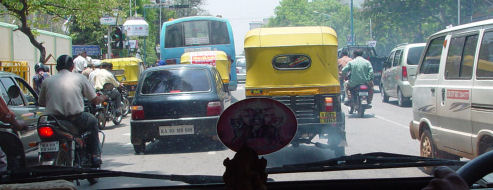
Traffic includes rickshaw taxi, motorbikes, and bicycles.
There's a video at YouTube of a traffic intersection in India. Here is a passenger's view. These are typical of what I experienced.
You should not drive in India. It's too chaotic. In fact, car rental companies won't let you drive. They include a driver for two or three dollars per day. Cars are very inexpensive to rent at only 3 cents per kilometer; I hired a car and driver to go to Mysore. The three-wheel rickshaw taxi are five cents per kilometer in the city, which means you rarely pay more than 20 cents. (Unless, of course, it's your first few days in Bangalore. If you don't pay attention, the rickshaw wallah overcharges you by ten times.)
In Maximum City, Mehta talks about how Indians "adjust." This is the real rule of the traffic system. They adjust. Everyone has a right to the road. They scoot over and share the road with trucks, buses, vans, jeeps, cars, rickshaws, motorcycles, scooters, bicycles, pushcarts, tractors, ox carts, cows, horses, camels, dogs, and people, both jaywalking across the road, and also walking along the road.
Going the wrong way on the highway? So? Several times I saw people driving on the wrong side of the highway. Oncoming traffic simply moved over. I was in a taxi when the driver took the wrong onramp and drove onto the highway in the wrong direction. He didn't notice at all. We drove along for several miles until there was an intersection that let him get back onto the correct side of the road.
Just sit in your seat and remind yourself; they're used to this. If that doesn't help, then remember there is reincarnation in India, so you'll eventually come back.
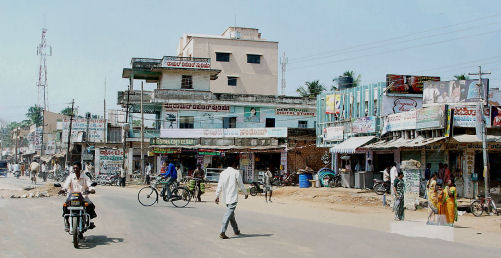
There are a number of small towns on the road to Mysore.
In North America and Europe, when you go from a side road onto a main road, you stop and look. Not in India. They simply honk their horn and swerve onto the road (it doesn't really matter much in which direction). Traffic just flows around them.
The main roads in the city and highways between cities are paved, but side roads and streets between houses are sometimes unpaved. Small roads in the countryside are also often unpaved and due to the very heavy traffic, the roads are actually a long series of deep potholes. You must drive slowly. Even on the highway, you drive slowly, 30-40 mph, due to the chaotic traffic. Although it's a highway, there are cows, ox-carts, and horses on the road, either going with the traffic, or often cutting across traffic.
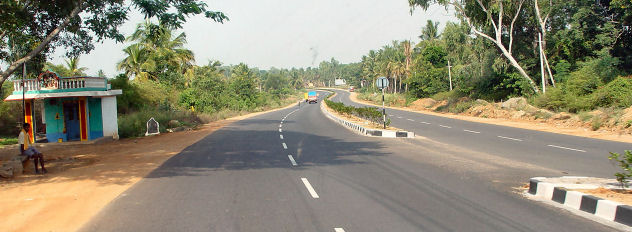
The highway to Mysore. India, like the UK, drives on the left-side of the road.
A solution to the traffic jams are "flyovers" (elevated roadways). The city is building more of these. But construction is slow and takes years. The only form of traffic control are speed bumps. These are very popular. They are placed everywhere.
It's difficult to find anything; they rarely put up signs with street names. House numbers are seldom. If you don't know where something is, you won't find it. In India, you must have friends or hire local guides to see the best places. I had the Lonely Planet guide for South India, and I saw a few of the restaurants they recommended. These were nothing compared to the ones that friends showed me.
There are thousands of motorcycles. These are light city bikes, mostly 150cc. Traffic is so heavy and slow that it doesn't make sense to have bigger motorcycles. Women ride on the back and sit sidesaddle. Motorcycles are often overloaded; dad, mom, and a kid on a motorcycle. Several times, I saw parents with two children on a motorcycle. Sometimes, dad wears a helmet, but nobody else. I saw perhaps only two women driving a motorcycle.
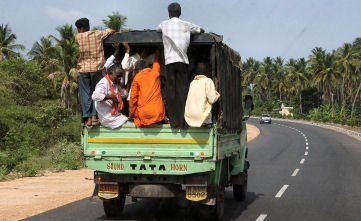
You often see bus or trucks heavily overloaded. A bus is jammed with people, and more are hanging from the door. Trucks are loaded with bags of produce, and on top, five or six people.
At night, they drive with low beams. When there's oncoming traffic, everyone switches to high beams. This means you can't see at all. Yet that's what everyone does. Of course, you should be glad that trucks use any lights. I saw many trucks driving in total darkness with no lights at all.
Sidewalks aren't meant for walking. Even in front of beautiful office buildings, sidewalks are sometimes broken. Sections are missing, pipes and metal rods stick out of the ground. If you don't pay attention, you can get hurt. Because of the condition of the sidewalks, people often step off the sidewalks onto very busy streets. Between my hotel and the company office, there was a major road construction site. Traffic flowed through the construction site. You walk over rubble, while large tractors back up around you. You walk past within inches of a welder (wearing no safety equipment at all). Indians don't notice this. For us, we have to be very careful.

The oxen, with beautiful sloe eyes and painted horns, are hauling sugar cane. The cart driver is perched on the yoke between the oxen.
The easiest way to get around in the city is rickshaws. These are motorized three-wheel carts, somewhat like a golf cart, with a 2-stroke engine that runs on propane. The rickshaw wallah (taxi guys) are like New York taxi drivers: they speak in one-syllable sentences, often refuse to take you where you want to go, try every way possible to overcharge you, and blow their horn at every passing car, rickshaw, cow, and bird. One night, we were driving along and there wasn't any traffic on the street. The driver honked anyway. Maybe it was too quiet. The taxi wallah are often harassed by the police for traffic violations, tho' with literally every vehicle and mammal violating the entire rulebook, it's hard to see why the police picks any particular driver. The driver offers a 100 rupee note (about $2) and the policeman forgets about the violation. This minor bribery is very common and although the traffic police earn very low salaries, they make up with the extra income.
Another odd thing is the assumption that the largest vehicle has the right of way. Cars are pushed aside by trucks and buses. Cars push 3-wheel carts and motorcyles aside. Everyone pushes pedestrians aside. Men in cars will honk at women with children and force them out of the way.
People drive fairly slow, so most accidents aren't dangerous. Hardly anyone wears seatbelts. There no seatbelts in the rickshaws (and no doors either). I doubt there are many airbags. The problem isn't the chaos; it's the lack of emergency care. If you're critically injured in Silicon Valley, emergency medical technicians (EMTs) arrive within 180 seconds. But in India, forget it. And if you are in an accident outside of a large city, well... The mortality rate per 100,000 is 15 in the USA and 24 in India (substantially higher), although not at bad as Central America, where macho drivers score a mortality rate of 46.
The airport is another traffic item. Bangalore has seven million people, San Jose has one million, yet Bangalore's airport is tiny. The lobby for international flights resembles a small and shabby Greyhound bus station in West Texas. A wall is missing. Airline signs are held up with pieces of tape. The departure process is haphazard. My flight was scheduled to depart at 11:50 pm, but they decided to leave at 10:15 pm. You're advised to arrive three hours before a flight and this is good advice; you'll get a seat in the waiting hall. Several hundred late arrivals stand for two hours or more. You leave this airport and go to Singapore, Hong Kong, and Seoul's airports, which are gleaming modern buildings with ultramodern malls. It's not that India is a developing country; they simply don't put much effort into fixing infrastructure, such as roads and airports. If they wanted to, they'd have modern roads and airports. They just don't put effort into roads.
And there's the electricity. The power often fails. Computer companies generally have power backup systems, so they just keep working.
The infrastructure is a mess. The CEO of Wipro threatened to pull out of Bangalore because the city doesn't have the political will to fix the problems. Many companies have set up operations in other cities, such as Hyderabad, Chennai, and so on. Nevertheless, Bangalore continues to grow rapidly.
India's Food and Drinks
One of the best things is the cuisine. No, that's understating it. India's cuisine is one of the best in the world. Food in every variety, combination, ingredient, flavor, spice, scent, and color. There are far many more dishes than what we see in Indian restaurants in Europe and the USA. There are thousands of restaurants, of all types, qualities, and sizes. There are types of restaurants that we don't have in the USA.

At many public places, such as the entrance to parks or zoos, there are street vendors, with roast corn, various types of nuts, cotton candy, fruit, ice creams, juice, sodas, or bottled water. In the photo, a woman is selling roasted ears of corn at the city park.
With millions of small farms, food is inexpensive. Biriyani (rice dish) is R40-50, or about a dollar. Most lunch is a dollar or less. A Pepsi is five cents (and two cents in the countryside). Tea is two cents. Restaurants range from air-conditioned to open-air, and even down to the bare minimum. On street corners, you'll see someone set up a small propane burner, a frying pan, and make various items. Their "shop" is perhaps two feet by two feet.
Western restaurants have Western prices. TGIF burgers are $10. I saw a few Subway and Pizza Hut, but no other franchises. Although there's McDonalds in India (with veggie Big Macs), I didn't see any. There is KFC, which has spicy chicken, but I didn't see one. In general, there are few foreign franchises.
There's lots of fruit, incl. various types of banana, including small bananas that are very sweet. And there are lots of mango and papaya. Mango trees are huge. You see durians bigger than large watermelons.
There's a full range of restaurants in Bangalore. One night, we went to Paparazzi, which Conde Nast lists as one of the 100 best restaurants in the world. It's on the 10th floor with a great view of Bangalore. A full bar with martinis and a menu where everything is unique.
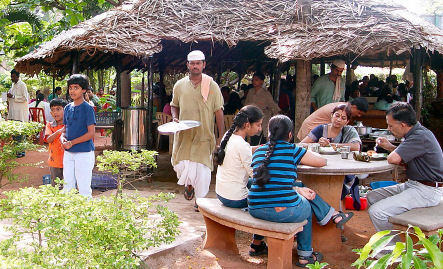
An open-air restaurant. You pay 50 rupee ($1US), get food at a buffet table, and sit wherever you find space.
At another place, I had a sandalwood drink. This is really amazing. In the West, we don't have drinks that are scented like perfumes. (Recipe for Sandalwood Drink: 1-1/2 quarts water, 4 drops sandalwood oil or 4 teaspoons sandalwood water, 5 cloves, 5 green cardamom pods, 1/2 teaspoon saffron, 1 cup honey or sugar to taste, juice of a lemon. Boil the water, cloves, and cardamom for 5-6 minutes. Add honey and sandalwood; boil until the syrup is thick. Remove from heat, add lemon juice, and chill.) I don't know why these perfumed drinks don't exist in the West. In Persian cuisine, there's rose water (rose-flavored water) which makes a delicious drink. Chanel and the various perfume lines could come out with perfumed drinks. These would be very cool.

Many street vendors sell fresh coconut milk. They open the coconut for you. These fellows pulled up in a small 3-wheel truck and began to unload coconuts to set up a stand.
As I said, it's hard to find things. If you don't know where something is, you won't even know it exists. Friends took us to restaurants, where from the street, all you see is a small non-descript sign. You go around the back, go up three or four floors, and there's a great restaurant. The few restaurants in Lonely Planet are not much in comparison.
In most restaurants, people eat with their fingers. You can ask for a fork, but you'll rarely get a knife, which you don't really need anyway. Restaurants often give you a finger bowl, both at the beginning and end of meals.
After most meals, there is a box of spices, which are breath fresheners.
Another thing that I've never seen in a US Indian restaurant is paan. These are small items that you eat at the end of a meal, after dessert. A betel leaf is filled with spices such as cardamom, anise, lime paste, grated coconut, betel nuts, and small piece of candied fruits. All of this is folded up in a small packet, pinned with cloves, and you pop it into your mouth. Incredibly delicious.
One of the common things about Indian restaurants in the USA is doggy bags (take home the leftovers). But nobody does this in India, and if you do, they think you're cheap.

Somehow, you don't expect coffee in India. You rarely see it in Indian restaurants in the USA. Yet India is the world's sixth largest producer of coffee and there are lots of cafes. Cafe Coffee Day (in the photo) is the Starbucks of India and they have the full range of coffee.
Sugar cane juice is sold everywhere. Fresh sugar cane is crushed and you drink the juice. Sometimes, they add a bit of ginger. Delicious. Why doesn't this exist in the US?
As for soft drinks, there's Thums Up (made by Coca-Cola, and it's sweeter and darker in flavor than Coke), Pepsi, and 7Up.
It's funny that in restaurants, the Pepsi and water are presented, like wine. The waiter presents the bottle of Pepsi.
The beer is quite good; there's Kingfisher and other Indian beers.

Because of the heat, dust, and humidity, you drink lots of water. It's useful to have a water bottle carrier that holds a liter water bottle. You need several liters of water in your hotel room. However, water purity is not good and if you drink tap water (or eat anything that was rinsed in tap water), you may get diarrhea. This is difficult to avoid, but luckily, it's also easy to treat. Indians also get sick, tho' not as much. By growing up in their environment, their bodies can better tolerate the water.
So, try new foods or get sick? Easy choice. Despite the risk (and yes, I got sick, but so what?), I tried many things that I've never seen before. Lime Drink (juice of limes, flavored with cardamom, crushed fresh ginger, and sugar) is extremely delicious.
Indian women love sweets and there are lots of candy shops. At several stores, I bought one of everything. Despite the tremendous amount of sweets, there isn't the obesity of the US; I suppose it's because they walk more.
And then there are the tiffin wallah (lunch box guys). Bombay has an ingenious meal distribution system. Tiffins are lunch boxes that hold warm food. The wife makes warm lunch, puts it in a tiffin, and this is delivered to the husband at his office desk. Every day some 4,000 tiffin wallahs go on bicycle through Bombay's suburbs, house by house, and pick up some 160,000 home-cooked lunches. They bring the tiffins to suburban railway stations and use a color-coding system to sort these by destination on the platform. The tiffins are loaded onto subways and passed along to other tiffin wallahs, who deliver these by lunchtime. Afterwards, the empty lunchboxes are collected from the offices and brought back to the home where they came from. A Forbes study found the tiffin wallah system has a six sigma accuracy, which means they deliver tiffins with an accuracy of 99.9999% (six nines). In other words, for every six million tiffins delivered, only one fails to arrive. That's about one lost tiffin every two months. Only top Western engineering companies achieve six-sigma quality. Bombay's tiffin wallah are illiterate, yet they manage to do this. Read more about the Bombay tiffin wallah and an article by Guardian on the Bombay tiffin wallah.
Caste and Religion
Everyone has heard about the caste system. There are four major castes, with sub-groups within each caste. There's a fifth caste, the Untouchables (called Dalit). And there's a sixth non-hereditary caste, made up of homosexuals, transvestites, and other social outsiders.
The caste system is much upon commented by foreigners, but this isn't really very different from socio-economic groups in the USA. Harvard and Stanford graduates don't mix with people from state community colleges; truck drivers don't mix with middle class, and so on. We have a caste system in the USA, but we call it social classes, based on education, income, neighborhood, and race. The difference is that the Western system isn't hereditary. It's possible to move out of one socio-economic group into another, and some do.
Most Indians (80%) are Hindu. Hindu is a very complex religion. How complex? They have 300 million gods. There are tens of thousands of local versions of Hindu. Because Islam conquered and ruled India for 600 years, about 140 million (13%) are Muslim, making India one of the largest Islamic countries in the world. There are also some 23 million Christians, mostly around Goa on the southwestern shore. The Christian community was founded by St. Thomas, one of the twelve disciples, 2,000 years ago, so India has been Christian far longer than most of Europe. There are also Sikhs (18 million), Zoroastrians (a 5,000-year old religion from Persia), Buddhists, Jains, and Jews (another ancient community.)
The West often sees India as a land of religion. In reality, India has a much deeper and longer secular and atheist tradition than the West. In the 1600s, Europeans were burnt at the stake for denying the christian god. Western secular thought is only 300 years old, and still not widely accepted in the USA. In contrast, India has had respected schools of atheism for over 2,000 years.
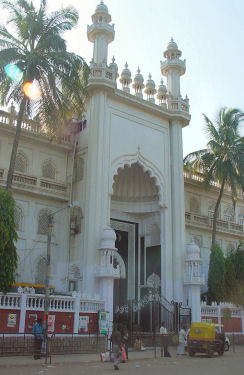
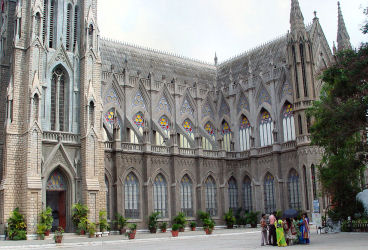
The Great Mosque in Bangalore. St. Philomena Cathedral in Mysore. Did you expect to see a gothic cathedral with flying arches in India?
Fashion Report
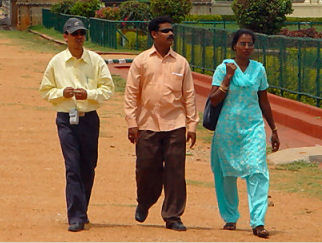
Clothes in Bangalore is a mix of traditional Indian clothing and Western clothes. Women wear sari, salwar kameez, or western clothes. This is a long loose knee-length shirt over a pair of light pants, adorned with a light silk scarf (a duppatta) around the neck. This is either very light cotton or silk, with colors and print patterns. The kameez is related to our Western shirts, as you can see with the name camisa in Spanish and chemise in French. It's also the origin of the Shimmy, a dance invented in Paris by Josephine Baker, who danced it wearing a man's open shirt (and nothing else).
For men, it's slacks and a button plaid cotton shirt. Young guys wear California graduate student clothing: a baseball cap, polo shirt or T-shirt, jeans, and sneakers or sandals. However, men don't wear shorts. Farmers and laborers often wear sarong or loincloths.
As for footwear, both men and women wear mostly open sandals. I'd guess 80% wear sandals or flip-flops. Otherwise, they wear sneakers or various types of sports shoes. Farmers often don't wear shoes and many don't even own shoes.
Clothes are inexpensive. India has a huge cotton industry and cotton is well-suited to the climate. Because of the warm weather and the humidity, sweaters, wool, and fleece jackets are useless in the south.
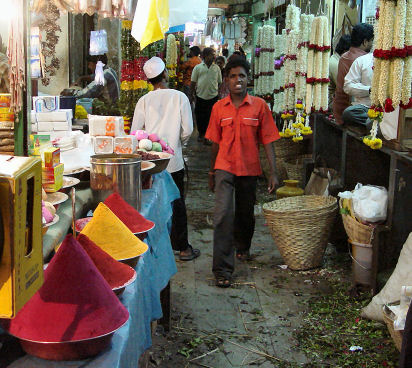
On the left are bowls of color for bindi, the dot of color that people have on their foreheads. At right hang thick garlands of jasmine, filling the market with scent. Women tie short strands of jasmine into their hair.
Nobody colors their hair. Although it's very popular among young Japanese women to color their hair brown, red, or blonde, this fad hasn't yet reached India. Everyone has dark hair. There isn't much hair styling like in California. Women have long hair, which they generally wear in a bun. Men have short combed hair.
People
Bangalore is the most westernized and modern Indian city, with a huge software and engineering industry, yet of about seven million people in Bangalore, there are only 15,000 foreigners (that's only 0.2%). TIME magazine reports there are only 30,000 foreigners working in India. Basically, you don't see foreigners. Maybe one or two if you go to MG Road, the main tourist area. At Cubbon Park on Sunday or the crowded City Market, I saw no foreigners of any kind: Chinese, Japanese, African, European, etc. In California, there are people from everywhere.
I was also in Mysore (700,000 people), a very popular tourist destination, and I didn't see any foreigners. In the evening, I went to a cultural event, where there were perhaps 20,000 people. I was perhaps the only non-Indian.
In comparison, Paris has 50,000 Americans and several hundred thousand people from other countries. It surprised me that there are so few foreigners in Bangalore. On second thought, India only opened up to the West in the mid-90s, so it's still fairly new to go there.
In Mysore, I was chatting with some people (people are friendly and easy to talk with). After a while, one asked if I was Indian. I said no, I was from California. Then he asked if I was a red Indian. The "non-Indians" they see are NRIs (Non-Resident Indians), who are "Foreign-born Indians," also called Desi. They are the children of Indians who came to the USA and Canada in the 60s and 70s. Many of them don't speak Hindi or know much about India. They can get a passport and don't need a visa. So the people in Mysore, who never see foreigners, assumed that I was a NRI. Who else comes there?
There's a difference between Indians and Desi (Desi are the Indians who live in the USA and Canada). A number of people in Bangalore asked me why Desi were so socially conservative. India continues to develop due to their internal dynamics, but the Desi left India 20 or 30 years ago and their cultural values are frozen at the year they left. Desi also tend to be educated in medicine or engineering and work for large corporations, so they have an upper-middle class corporate outlook. Living outside of India, they don't have exposure to the subcultures that make up daily life in India, and, as outsiders in the USA, they don't have contact to many American subcultures, so they tend to have an idealized worldview. I've noticed the same with Germans and Danes who left Europe 20-30 years ago. The Europe they knew is long gone. I've met Germans who came to the USA in the 40s who think of themselves as Germans, yet they have literally no idea what modern Germany is like. The same happens with Americans who left the USA in the 60s and live in Europe; the USA they know is from the 60s, as if the 60s were still going on. If you deal with Desi in the USA, keep in mind that they're not like Indians.
There is a general chaste sensuality. Long before California girls wore short tops to show off their tummy, Indian women wore sari which has a bare middle. Yet this isn't meant to be sexy like the US girls. There's plenty of advertising for cosmetics and fashion clothes, but nowhere as erotic or sensual as American advertising.
There's very little touching between couples on the streets. You don't see flirting like in California, and you certainly don't see sexual interest like in France or Germany. There's no touching in general. People don't give a hand to each other or touch each other at all.
Before Americans start to think they live in a loose society, they should see advertising in Europe. Many European ads, especially French, German, and Danish, can not be shown in the USA. The US, even California, is socially conservative compared to continental Europe.
Another difference is the general lack of teenage girls on the streets. In California, it's very common to see groups of teenage girls, in two, three, or five, at the shopping centers, malls, and downtown, and usually dressed very provocative. But I saw very few teenage girls in Bangalore. Young unmarried women live at home and generally have to be at home by 9 pm. They're not allowed out at night by themselves. Popular culture (fashion and so on) is created by teenage girls in Japan and California, but India so far has managed to prevent their teenage girls from becoming the center of popular culture. Models in advertising are in their mid-20s and 30s. In general, society is middle-age centric: young people marry in their early 20s and studied hard to enter professions. The desired state of life is to be a professional and married with children. Nearly all Bollywood movies are boy-meets-girl and ends with a marriage. In contrast, Californians and Europeans spend their entire 20s unmarried, and may live together, or often just live alone. Indians in their early 20s are mature and sensible, in contrast to Americans, who are mostly dazed into their 30s.
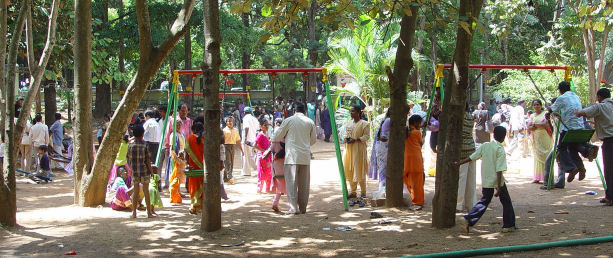
At the playgrounds in Cubbon Park.
In the Sunday papers, there were four pages of marriage ads. None were for dating or whatever. It's only matrimonial. The ads are sorted by location, religion, caste, language, nationality, or profession. And the ads are often placed by the parents.
Here's an example: "My daughter is a finance professional with certificates in computers. She is traditional and religious with a pleasing personality. She loves reading, Indian music, traveling, and sports. We belong to a respectable and educated family from West Bengal. We are a close-knit family and value our traditions and customs. I (her father) retired as Vice President (Finance) from a reputable firm. Her mother is a fine homemaker. My eldest son is married and works as senior IT professional in a Fortune 50 company in the USA. My daughter-in-law is a fine homemaker with a post-graduate degree in Hospital Administration." In another ad, the father states that he is a doctor who owns a 100-bed hospital and is looking for a wife for his son, who is also a doctor.
I don't think you'll see that in the personal ads in the USA. To see some of these ads, visit TimesMatri.com
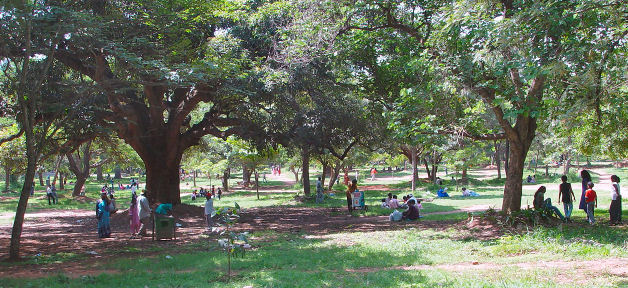
Families picniking in Cubbon Park.
I didn't see any openly gay men, which is common in California. I don't know what's going to happen when CraigsList opens up in India.
If you want to get an idea of India, watch Bollywood movies. Over the last six months, I've watched quite a few. Some are very good, such as Dil Chahta Hai, with three major Indian actors: Aamir Khan, Saif Ali Khan, and Akshaye Khanna. You can get these through Netflix and most video rentals.
As for books, Suketu Mehta's Maximum City is a description of life in Bombay. In a series of portraits, he talks with gangsters, Bollywood producers, politicians, businessmen, prostitutes, and police detectives. Another good book is Amartya Sen's The Argumentative Indian. Sen is a Nobel Prize winner in economics and a professor at Cambridge and Harvard (incl. professorships at Oxford, the London School of Economics, and so on) He is a major writer on the nature and impact of globalization. It's difficult to summarize his book in a few lines. See Amazon's page on the Argumentative Indian. I strongly recommend his book. I also read Upamanyu Chatterjee's August, English (a very funny satire of the Indian civil service. A slacker gets a job in the civil service and is sent off to a village, where he deals with his superiors, hangs out with his friends, smokes pot, and makes comments about his surroundings.)
Considering the broken sidewalks, it would be very difficult for handicapped persons to get around in Bangalore. I never saw anyone in a wheelchair, and I can't imagine how they would live there. Curbs are very high, often 12-18 inches, and sidewalks are often impassable. Some building owners don't want the expense of maintaining elevators, so they just board up the elevators. You walk up four flights of stairs.
I wrote about the police and bribes. The bureaucracy is another cause for bribery. With so much useless paperwork for everything, it's common to bribe civil servants to get things done. This means civil servants form a wealth class, with extra summer homes and so on. Corruption is widespread at the top of Indian politics. The inefficient infrastructure (bad water, poor roads, insufficient airports) may be due to corruption and siphoning of funds.
Like the sleepy crocodile and the dozing dogs, Indians may be one of the least athletic people on the planet. India's field hockey team won gold medals in the Olympics back in the 30s and 40s. That was enough sports for India. Although they have a billion people, India rarely gets any medals in the Olympics. Instead of twitching around on a sports field, they put their efforts into education and academics. There are literally hundreds of colleges and professional schools.
Everyone is busy. Even the poor are busy; they set up small stands to fix shoes. Someone sets up a chair and cuts hair. A knife sharpener goes around, sharpening knives for housewives. Flower vendors walk through the streets, selling garlands of jasmine. In tiny shops, a woman has a sewing machine and is making tailor repairs. Bring her whatever you have, and in two days, she'll make a replica of it for $4. In front of every temple, park, and public place, there are lots of stands selling fruit for five cents, snacks, water, and so on.
Everywhere I went, people were friendly and polite. Of the people I work with in Bangalore, they are highly educated (often with two degrees, some with degrees in both engineering and MBAs) and very bright. They understand complex issues immediately. In discussions, they make insightful comments. They are polite, considerate, and very easy to work with. With 20 years of TV, movies, MTV, and the web, they have a Western attitude and easily work in global business. They are like Californian graduate students, who just happen to eat a great deal of Indian food.
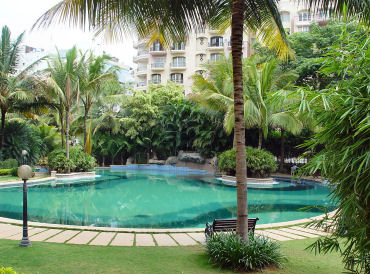
Although people in Bangalore complain about rents and home prices, these are low compared to California. A nice apartment rents for $200-240/month. A condo in a upscale complex is $60,000 and this includes swimming pools, tennis courts, a private park, and so on.
It's very safe on the streets. I walked around in many parts of town and was never bothered. You can even walk late at night; there are hundreds of people on the streets.
There weren't as many beggars as in Spain or Mexico. At major tourist sites, someone will ask you for money. Just ignore them. Before you buy anything, find out the normal price. Many shops will increase prices by ten times for you.
As for women travelers in India: Stephanie traveled in north India by herself and spent most of the time with several guides. On the few times she was by herself, she got too much attention. North India is also poorer so people harass tourists. In Bombay and Bangalore, Stephanie was able to walk around by herself.
Why Is there a Technology Boom in India?
Why, of all places, is there so much technology in India? Most Americans think India is a third-world country with Hindu gurus, Mother Teresa, and cows in the streets. How can India compete against US technology? Well, they're doing it.
How did this happen? How did a third-world developing country suddenly develop a highly-computerized infrastructure? This came about through various actions and accidents. Nobody planned this.
After the British left in 1947, India generally copied the Soviet Union's economic model. They nationalized the industries and socialized many social services. For forty years, from 1950 to 1991, a number of laws restricted growth and controlled business activity.
However, in the 50s, Prime Minister Nehru also built the IIT (India Institute of Technology), which became one of the world's leading engineering schools. But with the lack of industry and little career opportunity in India, IIT graduates went to the USA and Canada. Why those two countries and not Europe? Because Indians speak English, but they rarely speak other languages.
In the early 90s, Manmohan Singh, a professor of economics who was educated at Oxford and Cambridge, became the Minister of Finance. After more than four decades of socialist economics, India was basically bankrupt. The nationalized industries were backwards and unproductive. Singh simplified the tax laws and removed many of the bureaucratic barriers and burdens for business. For example, if a company builds software for export, it is tax-free. This created the legal and economic conditions for India's technology boom in the 90s. Singh is now the Prime Minister of India.
By the late 90s, the IIT graduates from the 60s and 70s began to retire and return to India. They had become extremely wealthy in Silicon Valley (many are billionaires who started or funded large SV corps, incl. SUN, Google, etc.) and they used their connections and money to build more companies. With 60 years of world-class education and a society that highly values education, India has a large pool of highly-educated technical workers that also happens to speak English as a native language.
Another accident was the dotcom boom in the USA. In 1996, President Clinton deregulated telecoms which created a massive amount of investment activity. VCs poured hundreds of billions into fiber optic cable. They over-invested and built not merely four times more than what was needed; they built 32 times more capacity. This of course was unsustainable, so the dotcom market crashed. The fiber optic networks had cost hundreds of billions but when these companies went bankrupt, other companies bought the networks for pennies.
Suddenly, all of this came together. A vast pool of technology workers who spoke English, lots of Indian venture capital money and people who could manage investments, a post-dotcrash US market that demanded new companies to be both financially efficient and profitable, and a vast global telecoms infrastructure that was available for basically free.
Bangalore is the Silicon Valley of India. Wipro and InfoSys, two major Indian offshoring companies, are headquartered there. Many global corps also have large campuses, including IBM, Microsoft, SUN, and so on.
Most Americans think of India as call-centers (they handle your calls when you call an airline, car rental, etc.) But that's the lower end of the system. India's engineers are designing, developing, and building much of the computer hardware and software for large corporations.
This is a very serious issue for the American workforce. Thomas Friedman's The Earth Is Flat compares the quality of education in India and the USA. While India's students study very hard and are excellent in science and mathematics, American students watch too much TV and do little homework. Compared to other countries, American students are near the bottom and are sliding downwards. Friedman points out that if the USA were to have a massive investment in education and completely revamp the American education system, it would take ten years to see results because you have to start with kids in the fourth and fifth grade (and basically write off the entire current generation of high school and college students). But in ten years, India will be yet further ahead. And we all know a major restructuring of the education system isn't going to happen in the USA.
So… where will the future of the economy be? For the last 60 years, the USA has been the center of the world economy. But this has shifted now to a global economy. The technology infrastructure of India, China, Korea, Singapore, Malaysia, and the rest of Southeast Asia is growing very fast. I wrote above that the airport in Bangalore was shabby compared to American airports. Well, I've never seen an American airport as beautiful as the airport in Singapore.
Traveling
Finally, a few notes about traveling to India.
There are two necessities in India: bottled water and cell phones. India is on the GSM cellular standard, as the rest of the planet except the USA. You buy a GSM phone handset in Hong Kong or Singapore for $100. In India, go to any major cellphone service and buy a SIM card. This assigns a phone number to your handset. You also buy minutes. Just push a button and you can see how much money you have left. There are cell phone stands in every street where you can "top up" the SIM card and add more minutes. The cell phones also send SMS messaging. It's necessary to buy a cell phone because it is so difficult to get around. You call friends, set up meetings, call people in the USA, and so on. Since it's GSM, you can use the cellphone when you go to Europe.
As for water: one day, Stephanie said "Watch that bottle. Water is more valuable than gold here." And it's true. You can only drink bottled water from a sealed bottle. Otherwise, you can get very sick and lose several days of your trip. We take clean water for granted in the USA. One night, I ran out of water in my hotel room. I called the front desk, but they had no more water. You need water; the air conditioner runs all the time and the air is very dry. I had to buy several 7-Ups. It's very odd to brush your teeth with 7-Up.
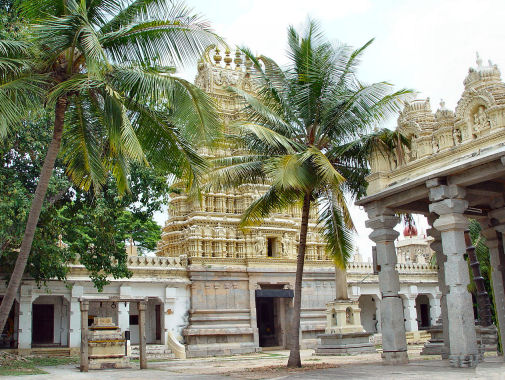
A temple on the grounds of the Mysore Palace. The temple is enclosed within a high wall, so it's peaceful inside. Before the entrance, you can see several pillars, in granite and iron. These phallic pillars stand before the opening to the temple. I started talking with a monk and he showed me around.
Don't take dollars or traveler's checks to India; it's nearly impossible to exchange money. On the first day, I tried to exchange some dollars. I went to four different banks. At the fifth bank, the exchange process involved four staff and quite a bit of paperwork and signatures. ATMs are much easier: pop in the card, withdraw, you're done. I think that's why there are so many ATMs; banks are very inefficient. There are ATMs everywhere.
Before you go, look into vaccinations. Depending on where you are in India, you may be exposed to malaria, typhoid, yellow fever, hepatitis, and rabies. Get vaccinations and prepare to get sick. With so much dust in the air, you will get sick. Diarrhea is easily cured with Imodium (start with two and take one on every bowel movement). If it lasts more than six hours, take Cipro (Ciprofloxacin, a prescription bacterial antibiotic) as well. This can cure you in a day.
It's also useful to bring a thermometer. Both Stephanie and I got viral fever, which is common before the monsoon season. This includes high body temperature.
Westerners get sick because we're not used to the amounts of bacteria and virus in the water and air. Indians also get sick, but not as often. Their immune systems have built up resistance. Still, they get sick and accept it. They don't realize that it's normal for us not to be sick. As I said, I got viral fever and I haven't been that sick in maybe ten years.
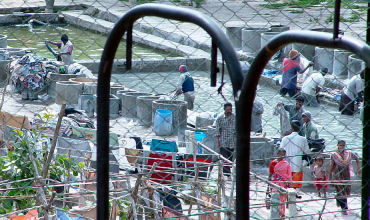
When I go to Europe, I travel light and wash clothes at Laundromats. But this doesn't work in India because there are no Laundromats.
Clothes are sent out to be washed by hand and this takes three days. The clothes are collected and sent to places where a dhobi wallah (a washer guy) beats your clothes on a rock. They really do this. Then your clothes are dried in the sun, folded, and returned to you.
With so many people, it's cheaper to hire them to wash by hand than to buy a expensive machines that require maintenance.
So, bring sufficient clothes and when you need things to be washed, send it out early.
Let's be clear about this: it's not easy to go to India. I've flown back and forth to Europe so many times that I've lost count. Europe is a long flight. But it's an extremely long flight to India. The San Francisco-Singapore flight is 18 hours. The layover in Singapore can be ten hours. Door to door, it's 30-35 hrs. But the flights generally depart at midnight, so you've been awake all day. On the return flight, I was awake for 52 hours. I woke up at 7 am on Friday and arrived in Palo Alto at 2 am on Sunday. It takes a solid week to recover from a two-week trip.
We flew on Singapore Air (their motto: "You can't possibly get bored"). If you're going to spend 30 hours on an airplane, each seat has a video panel and they offer 60 movies, 90 video games, and 200 CDs. There's also endless food and an open bar. The airport at Singapore is a mall with every major global brand. You can take a free bus and see the city. For that much sitting in airplanes, wear loose clothing and loose shoes. I took an extra set of clothes so I could change halfway.
Our tickets were arranged by our office manager, so I didn't deal with that. If you're looking for tickets, I bought tickets for a flight to Europe this summer. Be careful with prices on ticket sites: they say $1,000, but then they add airport taxes, and these can be $200-300. So, look for the final price, taxes included. I compared the same trip on QIXO.com, Kayak.com, CheapTickets.com, Hotwire.com, Expedia, and Travelocity. Kayak.com offered the best prices ($700 cheaper than Travelocity) and a selection of flight times.
Weather and Climate
Bangalore is 920 m above sea level (3,000 feet) in the center of south India. There are mountain ranges (the ghatt) along the eastern and western side, so Bangalore is protected. In May, it was in the high 80s (F) and low 90s. However, the humidity is very high. There is extensive use of air conditioning. Loose, light clothing with sandals is sufficient.
I live in Silicon Valley, where it is in the low 90s in summer. For me, Bangalore's weather was fine. Others tell me that it's very hot in north India, where temperatures often reach 110° F.
Things to Buy
I didn't buy much stuff. If you want music CDs, these cost about the same as American prices, or you buy them in shops that make duplicates. You can also get CDs with MP3 music, which means as many as 190 songs on one CD. Stephanie bought several sets of clothes. At the Leela Mall, she bought a gorgeous silk blouse, silk pants, and a scarf for $12.
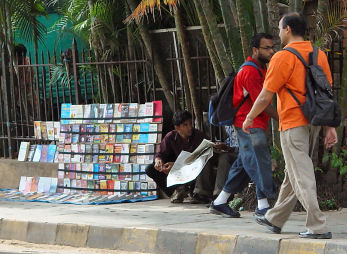
On the streets, there are vendors who sell pirate copies of books for $1. You can get The DaVinci Code, Malcolm Gladwell's Blink, and most best-sellers for $1. In most cases, you have to bargain. Otherwise, prices are doubled or tripled if you don't know. Ask friends first to get an idea of what prices should be, and then negotiate with the book wallahs. In malls and larger stores, prices are stated on the items.
In general, because of the vast labor pool, things are inexpensive. At Mysore, I went to the sandalwood oil factory and bought soap and incense, and other items. Enough incense to start my own temple was only $3.
They use rupees, which are about 45 to $1US. 100,000 rupee are called a lahk. For example, a car costs 4.5 lahk. People say their salary in lahk: "She earns six lahk." They also use crore (pronounced kror) for 100 lahk (i.e, ten million rupee, or about $222,000.) The price of buildings and large projects are stated in crore. It's also popular to say bucks instead of rupees.
In Summary
From what I've written, you can see that it's impossible to summarize in a few sentences. Amartya Sen points out that India is perhaps the most multi-cultural country on earth. India has been poly-lingual (with 1,600 languages), poly-religious (Christianity has been there for 2,000 years), and poly-cultural for nearly 5,000 years. They even have 30 different calendars. India is many different countries all in the same space.
So, what's the bottom line? You must go to India and see it, even if only once. It's an overwhelming experience of total chaos, amazing complexity, incredibly delicious food, and great people, all in a very active country racing forward. India will become a major player in the global economy.
